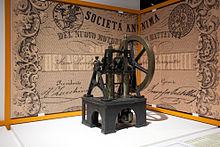Eugenio Barsanti
Father Eugenio Barsanti (born October 12, 1821 in Pietrasanta , Tuscany , † April 18, 1864 in Seraing , Belgium ), also called Nicolò , was an Italian engineer who developed the first internal combustion engine together with Felice Matteucci . On June 12, 1857, the two registered the following patent in London: "Specification of Eugene Barsanti and Felix Matteucci, Obtaining Motive Power by the Explosion of Gasses".
There is only one drawing from 1858 left.
life and work
Barsanti was born in Pietrasanta in Tuscany . He was short and slim. He studied in a religiously and scientifically oriented institute near Lucca in Tuscany and in 1838 became a novice in Florence with the Piarists (Italian also: Scolopi), who were known for their scientific studies.
In 1841 Barsanti began to teach at the Collegio San Michele in Volterra . Here, during a lecture on the explosion of a hydrogen- air mixture, he recognized the potential to use the energy of the expansion of the combustion gases in an engine.
Later, while teaching at an institute in Florence, he met Felice Matteucci , a hydraulic engineer. Matteucci loved the idea for the machine and the two men worked together for the rest of their lives.
They patented their invention in London on June 12, 1854 , because Italian laws at that time could not guarantee adequate international protection. The prototype was later completed in the 1860s. The year of the invention is 1853.
The main advantage of the Barsanti-Matteucci engine was the use of the return force of the piston by cooling the gas. Other developments based on the propulsive force of the explosion, such as that of Étienne Lenoir of France , were slower. The Barsanti Matteucci machine proved to be more efficient and won a silver medal from the Institute of Science of Lombardy .
In 1856 he developed a two-cylinder 5 hp engine and two years later they built a counter-rotating two-piston machine .
Barsanti estimated that the new engine was a great improvement over the steam engine , much safer, less cumbersome, and quick to operate. However, it was not yet light enough to be used in an automobile. The main aim was to provide mechanical energy in factories and for propulsion of ships .
After some searching, Barsanti and Matteucci chose the foundry of John Cockerill in Seraing in Belgium to a four-horsepower machine to mass produce it. Orders for the machine soon followed from many European countries.
Barsanti suddenly died of typhus in Seraing on April 18, 1864 and Matteucci was unable to run the business on his own. The development of the machine failed and Matteucci returned to his first job ( hydraulics ).
When Nikolaus Otto patented his engine, Matteucci unsuccessfully claimed that he and Barsanti were the original inventors.
Barsanti and Matteucci are featured on an Italian stamp from 2003 commemorating the 150th anniversary of the invention.
Web links
- Replica in the Deutsches Museum
- Animated machines - with different types of machines
- How an internal combustion engine works - with animation
- Birthplace of Eugenio Barsanti - his place of birth
- Padre Eugenio Barsanti
Individual evidence
- ↑ Barsanti Eugenio. Retrieved July 6, 2019 .
- ↑ patent
- ^ Museo Galileo Istituto e Museo di storia della scienza Piazza Giudici 1, Firenze, ITALIA: Documenti Società anonima del nuovo motore Barsanti e Matteucci (Firenze). (PDF) (No longer available online.) Archived from the original on February 22, 2014 ; accessed on May 28, 2018 . Info: The archive link was inserted automatically and has not yet been checked. Please check the original and archive link according to the instructions and then remove this notice.
- ↑ http://www.barsantiematteucci.it/inglese/documentiStorici.html
| personal data | |
|---|---|
| SURNAME | Barsanti, Eugenio |
| ALTERNATIVE NAMES | Nicolò |
| BRIEF DESCRIPTION | Italian engineer and inventor of the first internal combustion engine |
| DATE OF BIRTH | October 12, 1821 |
| PLACE OF BIRTH | Pietrasanta , Tuscany |
| DATE OF DEATH | April 18, 1864 |
| Place of death | Seraing , Belgium |

